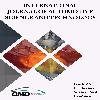Conversion of Aluminum Front Bumper System to Magnesium Material by Using Design of Experiment Method
Bumper and crash boxes are vehicle structural elements that convert the collision (kinetic) energy at the collision into deformation energy. Failure of the bumper system to sufficiently absorb the collision energy in the event of a collision will result in the resulting forces being transferred directly to the driver and passenger area. It will result in deaths or injuries to people in the vehicle and further damage to the vehicle. In this study, the collision performance of an existing aluminum crash bumper system produced by the extrusion method with a 40% offset collision analysis is examined. A magnesium crash bumper with improved collision performance is designed by this reference. In this design process, the design of experiment method is used. With the combinations created with the Taguchi method, the long design and analysis process is completed in a shorter time. Taguchi experiment design process; four different design variables and three-level combinations of these variables are used. With the table's help created at the L9 level, models corresponding to the variables are prepared, crash analyzes are performed with finite element analysis, and crash performances are examined. After revealing the results, optimization is carried out with Minitab software; the optimum design is achieved in crash performance and lightness.
Keywords:
Crash Bumper, DOE, Finite Element Analysis Magnesium Extrusion, Taguchi Method,
___
- [1] Office of Transportation and Air Quality, Regulatory Announcement:EPA and NHTSA Propose to Extend the National Program to Reduce Greenhouse Gases and Improve Fuel Economy for Cars and Trucks,2011. EPA-420-F-11-038.
- [2] Kiani, M., Gandikota, I., Rohani, R., Motoyama, K. (2014) “Design of Lightweight Magnesium Car Body Structure Under Crash & Vibration Constraints”, Journal of Magnesium and Alloys, 2, pp. 99-108.
- [3] Musfirah, A.H., Jaharah, A.G. (2012) “Magnesium and Aluminium Alloys in Automotive Industry”, Journal of Applied Sciences Research, 8(9), pp. 4865-4875.
- [4] Mert, F. (2012), “Magnezyum Alaşımlarının İşlenmesi”, 3. Ulusal Talaşlı İmalat Sempozyumu, 04-05 Ekim 2012, Ankara, Türkiye.
- [5] Akdoğan, A. (2008), “Magnezyum ve Magnezyum Alaşımları Ders Notları”, YTU
- [6] Webb, D. (2005), “Magnesium Supply and Demand 2004”, The 62nd Annual World Magnesium Conference, 22-24 May 2005, Berlin, Germany.
- [7] Gökçe, B., Taşgetiren, S. (2009), “Kalite İçin Deney Tasarımı”, Makine Teknolojileri Elektronik Dergisi, Cilt: 6, No:1 (71-83)
- [8] Yıldırım, A. (2017), “Sac Şekillendirme Etkisi Dikkate Alınarak Yüksek Performanslı Taşıt Pasif Güvenlik Sistemlerinin Geliştirilmesi”, Bursa Teknik Üniversitesi, Fen Bilimleri Enstitüsü, Yüksek Lisans Tezi
- [9] Öztürk, F., Kaçar, İ. (2012), “Magnezyum Alaşımları ve Kullanım Alanlarının İncelenmesi”, Niğde Üniversitesi Mühendislik Bilimleri Dergisi, Cilt: 1, Sayı:1 (12-20)
- Yayın Aralığı: Yılda 4 Sayı
- Başlangıç: 2016
- Yayıncı: Otomotiv Mühendisleri Derneği
Sayıdaki Diğer Makaleler
Erol Arcaklioğlu, Özer Can, Erkan Öztürk
Modeling, Simulation and Validation of a Tractor Wet Clutch Controlled by Proportional Valve
Haydar Livatyali, Ali Evren Yel
Modeling Simulation and Validation of a Tractor Wet Clutch Controlled by Proportional Valve
Hasan Öktem, İlyas Uygur, Gülşah Akıncıoğlu, Sıtkı Akıncıoğlu
Mustafa Babagiray, Hüseyin Bayrakçeken, Faruk Emre Aysal, Zekeriya Girgin
